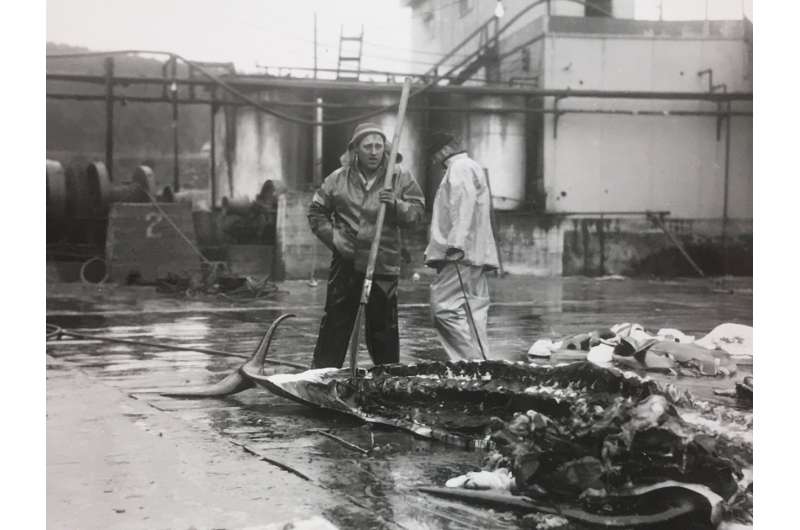Whaling in the 20th century. Credit: Courtesy of Dr. James Mead, Smithsonian Institutions
In a follow-up to their groundbreaking study, Baylor researchers were able to reconstruct baleen whales' lifetime stress response to whaling and other manmade and environmental factors spanning nearly 150 years.
Using a technique they pioneered six years ago, Stephen J. Trumble, Ph.D., associate professor of biology, and Sascha Usenko, Ph.D., associate professor of environmental science, both in Baylor University's College of Arts & Sciences, analyzed earplug laminae, a growth layer representing six months found in whale earwax, as part of their recent study published in Nature Communications this month.
Using earplugs taken from fin, humpback and blue whales originating in the Pacific and Atlantic Oceans from 1870 to 2016, Trumble and Usenko were able to determine the whales' cortisol levels, a stress-response hormone, to industrial whaling, World War II wartime activities and sea-surface temperature.
"This is the first-ever study to quantify temporal stress patterns in baleen whales," Trumble said. "While the generated stress profile spans nearly 150 years, we show that these whales experienced survivor stress, meaning the exposure to the indirect effects of whaling, including ship noise, ship proximity and constant harassment, results in elevated stress hormones in whales spanning vast distances."
Whaling had a significant impact on whales' cortisol levels. During the 1960s when whaling was at its peak with 150,000 whales harvested, cortisol peaked to a maximum and was the highest average in whales in the 20th century, according to the study's findings.
During World War II when whaling declined, whales still showed an increase in cortisol levels. Trumble and Usenko suggest the impact of the theater of war.
"The stressors associated with activities specific to WWII may supplant the stressors associated with industrial whaling for baleen whales," Usenko said. "We surmised that wartime activities such as under water detonation, naval battles including ships, planes and submarines, as well as increased vessel numbers, contributed to increase cortisol concentrations during this period of reduced whaling."
When whaling moratoriums were introduced in the mid-1970s, whaling decreased as well as cortisol levels—reaching their lowest concentrations.
"From the 1970s through the 2010s whaling counts were reportedly zero in the Northern Hemisphere, but mean cortisol levels steadily increased, with recent peaks reaching near the maximum levels observed before whaling moratoriums," Usenko said.
The impact of stress on whales could have larger implications for baleen whales, which are "considered sentinels of their environment and indicators of anthropogenic or manmade stressors," Usenko said.
"This study shows that anthropogenic stressors results in a physiological response in large whales. These chronic stressors may impact life history events such as reproductive parameters," Trumble said. "Lastly, human-based stressors such as warming sea surface temperatures may also result in elevated stress in these whales."
The research pair has expanded the number of museums they partner with and currently have more than 100 additional earplugs to process. Earplugs were provided through a collaboration between the investigators and the Smithsonian Museum of Natural History and the Museum of Natural History London.
More information: Stephen J. Trumble et al, Baleen whale cortisol levels reveal a physiological response to 20th century whaling, Nature Communications (2018). DOI: 10.1038/s41467-018-07044-w
Journal information: Nature Communications
Provided by Baylor University























